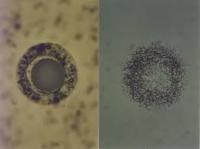-
Inspired by cats’ eyes, new camera can look inside nuclear reactors

Currently 11 percent of electricity worldwide is generated by nuclear reactors. There are 435 reactors in operation with another 71 under construction. Engineers, drawing inspiration from the eyes of cats, have created a new camera that can see radiation coming from nuclear reactors — boosting safety, efficiency, and helping during nuclear disaster emergencies.
-
-
Search in Illinois, Indiana for missing canister holding radioactive materials
Teams from the Illinois Emergency Management Agency (IEMA) are continuing their search in Illinois and neighboring Indiana for a missing steel canister containing radioactive material. The locked steel canister was last believed to be in a custom oil well logging truck. The nuclear material was used by an Illinois company specializing in surveying oil wells.
-
-
$100 million NIAID contract to SRI International to develop radiation exposure treatment

SRI International has been awarded a resource contract of up to $100 million over five years by the National Institute of Allergy and Infectious Diseases (NIAID), part of the National Institutes of Health, for the development of products to mitigate or treat acute or delayed effects of radiation exposure.
-
-
FBI helps foil several plots to sell nuclear material in Moldova’s black market
Over the past five years, four attempts by Russian gangs in Moldova to sell nuclear material have been thwarted by the FBI and Moldovan authorities. The most recent case was in February when a smuggler, who specifically sought a buyer from Islamic State, offered undercover agents a large amount of radioactive caesium. The would-be smuggler wanted €2.5 million for enough radioactive material to contaminate several city streets.
-
-
Animals have returned to Chernobyl

In 1986, after a fire and explosion at the Chernobyl Nuclear Power Plant released radioactive particles into the air, thousands of people left the area, never to return. Now, researchers have found that the Chernobyl site looks less like a disaster zone and more like a nature preserve, teeming with elk, roe deer, red deer, wild boar, and wolves. The findings are a reminder of the resilience of wildlife.
-
-
Upholding disarmament agreements with engineering
Arms control agreements face a problem: how to ensure that countries with nuclear weapons abide by disarmament agreements. The linchpin of these agreements is being able to verify that the signers are following the rules — but the trick is for both sides, or a third party, to be able to police weapons in a way that doesn’t give out too much information about them, for example, how these weapons were built. An MIT project, called Zero Knowledge Warhead Verification, tackles this problem with a beam of light, a scrambler, and a detector.
-
-
Mighty Saber demonstrates post-nuclear detonation technical forensics capabilities
In late 2013, a team of more than fifty scientists from across the U.S. laboratory and industrial complex began preparing for Mighty Saber with the goal of demonstrating and evaluating post-detonation technical nuclear forensics capabilities following a simulated detonation of a nuclear device in an urban environment. Mighty Saber, which ran from 27 July to 21 August 2015, successfully met each of its objectives, including demonstrating U.S. government post- detonation nuclear forensics processes; the value of prompt diagnostics data provided by the Discreet Oculus ground-based sensor network; and how prompt diagnostics complements radiochemistry in providing a robust post-detonation nuclear forensics capability.
-
-
Radioactive contaminants found in coal ash from all three major U.S. coal-producing basins

A new study has revealed the presence of radioactive contaminants in coal ash from all three major U.S. coal-producing basins. The study found that levels of radioactivity in the ash were up to five times higher than in normal soil, and up to ten times higher than in the parent coal itself because of the way combustion concentrates radioactivity. The finding raises concerns about the environmental and human health risks posed by coal ash, which is currently unregulated and is stored in coal-fired power plants’ holding ponds and landfills nationwide.
-
-
Ukrainian security services stop criminal gang from selling uranium
The security services of Ukraine say they have seized a small quantity of ore-grade uranium from a criminal gang in the western part of the country. The State Security Service of Ukraine (SBU) said the group had been trying to sell the uranium-238 isotope to an unknown client when they were arrested. Ukrainian media has recently reported of speculations about pro-Russian rebels’ ability to develop a “dirty” bomb which would use conventional explosives to scatter lethal radioactive fallout.
-
-
Israeli port evacuated after container emitting suspicious radioactive radiation detected
Israeli authorities on Monday evacuated the Ashdod port in southern Israel after an Israeli shipping container which arrived on a Chinese ship was detected to emit irregular radioactive radiation. By mid-afternoon, the port went back to normal operation. Israeli ports have installed advanced radioactive radiation systems in an effort to detect “dirty bombs” which terrorists may try to smuggle into Israel.
-
-
New reference material to help monitor oceans’ radioactive contamination
NIST is making available a new reference material which will help laboratories accurately measure radioactive contamination in seawater. The new reference material, a mixture of freeze-dried, powdered shellfish, provides a benchmark for scientists analyzing the local ocean environment’s level of contamination — for example, after an accident such as the 2011 nuclear plant disaster in Fukushima, Japan.
-
-
The Joint Comprehensive Plan of Action “kicks the can down the road”: How to prepare for the day when the can finally lands
The Institute for Science and International Security has published a series of briefs analyzing different aspects of the agreement reached between the P5+1 and Iran over the latter’s nuclear program. One brief deals with what the United States and the other world powers need to do now to prepare for what may happen in Iran in ten to fifteen years when many of the limits the agreement imposes on Iran’s nuclear activities will expire. The agreement does not prohibit Iran from building a large uranium enrichment capability and even a reprocessing, or a plutonium separation, capability. The agreement essentially delays the day when Iran reestablishes a nuclear weapons capability and possibly builds nuclear weapons, that is, the agreement essentially “kicks the can down the road.” Prudent planning requires careful efforts now to prepare for the day when the can lands.
-
-
Inspection regime in Iran informed by lessons from Iraq experience
Many critics of the agreement reached between the P5+1 and Iran over Iran’s nuclear program are especially concerned with the inspection regime negotiated in Geneva. The initial goal of the world powers was, in President Barack Obama’s words, an “Anywhere, anytime” inspections, but the deal finally reached saw the two sides agree to inspection procedures which fall short of that goal.
-
-
SRI International working to develop screening device for radiation exposure
radiation that may lead to severe health consequences post-exposure. To rapidly triage large numbers of people to determine who needs immediate treatment, a new, simple screening test is needed. Currently, if a person has absorbed a significant dose of ionizing radiation, there is nothing that can be done beyond waiting to see what symptoms develop, which roughly correlate with exposure level. SRI International has been awarded a $12.2 million contract to continue development of a diagnostic test for absorbed doses of radiation following a radiological incident.
-
-
- All
- Regional
- Water
- Biometrics
- Borders/Immig
- Business
- Cybersecurity
- Detection
- Disasters
- Government
- Infrastructure
- International
- Public health
- Public Safety
- Communication interoperabillity
- Emergency services
- Emergency medical services
- Fire
- First response
- IEDs
- Law Enforcement
- Law Enforcement Technology
- Military technology
- Nonlethal weapons
- Nuclear weapons
- Personal protection equipment
- Police
- Notification /alert systems
- Situational awareness
- Weapons systems
- Sci-Tech
- Sector Reports
- Surveillance
- Transportation
Advertising & Marketing: advertise@newswirepubs.com
Editorial: editor@newswirepubs.com
General: info@newswirepubs.com
2010-2011 © News Wire Publications, LLC News Wire Publications, LLC
220 Old Country Road | Suite 200 | Mineola | New York | 11501
Permissions and Policies
Editorial: editor@newswirepubs.com
General: info@newswirepubs.com
2010-2011 © News Wire Publications, LLC News Wire Publications, LLC
220 Old Country Road | Suite 200 | Mineola | New York | 11501
Permissions and Policies
